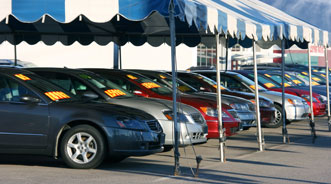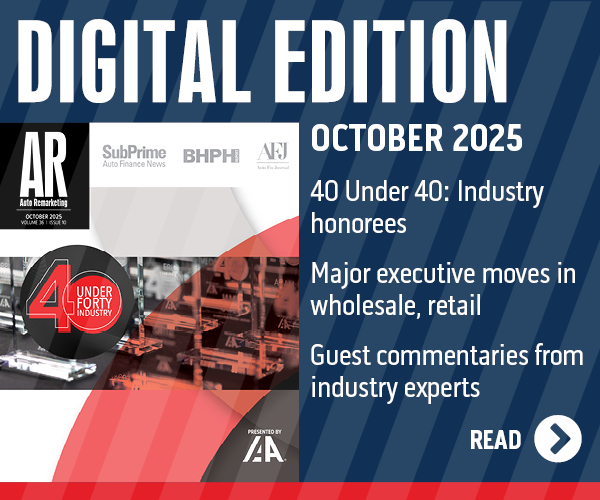Projections for New-Car Sales Improve, but Still Struggle to Get Over Hump

By subscribing, you agree to receive communications from Auto Remarketing and our partners in accordance with our Privacy Policy. We may share your information with select partners and sponsors who may contact you about their products and services. You may unsubscribe at any time.
SANTA MONICA,Calif. –
While the projections for August car sales differ from analyst to analyst, a common theme is brewing in their forecasts: the new-vehicle market — though still climbing — can’t seem to reach its full potential as downward economic and industry factors are limiting the auto recovery.
Whether the main culprit is the topsy-turvy stock market, a sagging economy or low incentive levels, new-car sales aren’t quite moving out of first gear, experts say.
The respective monthly new-vehicle sales predictions from J.D. Power and Associates, TrueCar.com and Edmunds.com range from 1.075 million units to 1.087 million units. And though all three firms are eyeing varying degrees of year-over-year growth in the market, analysts with each company stressed how auto sales haven’t quite made it over the hump.
TrueCar, which released its forecast on Thursday along with Edmunds, is predicting that new-car sales (including fleet and retail) will jump 8 percent year-over-year, improve 1.7 percent sequentially and hit 1.077 million units for August.
The resulting seasonally adjusted annualized rate, according to TrueCar, would be static month-over-month at 12.2 million. In August 2010, the SAAR was 11.5 million units.
The market may be improving, but it’s just a far cry from the gains analysts had predicted earlier, TrueCar said.
Subscribe to Auto Remarketing to stay informed and stay ahead.
By subscribing, you agree to receive communications from Auto Remarketing and our partners in accordance with our Privacy Policy. We may share your information with select partners and sponsors who may contact you about their products and services. You may unsubscribe at any time.
“The auto industry is a mixed bag this year, due to economic uncertainty; sales have improved compared to last year, but nowhere near the potential we had expected,” explained Jesse Toprak, TrueCar’s vice president of industry trends and insights. “The strongest correlation to new-car sales is the Dow Jones Industrial Average, and it was shaky and nervous in August.”
Over at Edmunds, the forecast is brighter at 1.087 million sales. However, the firm’s SAAR prediction of 12.3 million units is essentially static from a month ago.
Chief economist Lacey Plache suggested that the weak economy is leading many consumers to hold off on purchasing vehicles, even though buying conditions are ripe.
“Auto sales stayed on a relatively flat road this month, even as the stock market took a roller coaster ride,” Plache explained.
“Stronger buying conditions are telling consumers to go ahead and make their car purchases, but a weak economic landscape is telling them to wait until later this year, or even longer,” Plache added. “This is the battle that will determine exactly how much the auto industry will grow this year.”
J.D. Power, for one, doesn’t believe it will grow as much as previously expected.
Last week, the firm trimmed its full-year total sales forecast from 12.9 million units to 12.6 million units. J.D. Power initially believed 2012 new-car sales would hit 14.7 million; now it forecasts a softer market at 14.1 million sales.
“The economy and automotive industry continue to wrestle with a series of unsettling developments, which are now likely too strong to overcome within 2011,” said John Humphrey, the company’s senior vice president of automotive operations.
“While it is not time to hit the panic button, it is clear that ascending from the recession is proving to be just as bumpy as the decline into it, and a full recovery in vehicle sales is further down the road than previously thought,” he continued.
As for August, J.D. Power is expecting that the industry will move 1.075 million new vehicles and achieve a SAAR of 12.1 million, softer than the projections at TrueCar and Edmunds.
For the retail side of the market, specifically, the forecast is for 898,000 units. The resulting retail SAAR would be 9.9 million, compared to 9.5 million in July and 8.4 million a year ago.
“The selling rate in August is expected to be slightly stronger than in July, but without a significant increase in incentive levels or a reversal of the economic woes, there isn’t a compelling reason for those consumers sitting on the fence to return to dealer showrooms and purchase a vehicle,” said Jeff Schuster, J.D. Power’s executive director of global forecasting, commenting on retail trends. “There is little question that a strong level of pent-up demand exists, but economic and financial uncertainty is keeping it from being released.”
The fleet side of the market is typically softer in August, as is also common in July, J.D. Power explained. The company predicts 177,000 fleet sales for this month, a 16-percent share of the market.
Nissan Grabs Share
Moving along, TrueCar and Edmunds each broke down their forecasts by manufacturer.
Edmunds honed in on Nissan, which it believes will see the most sequential and year-over-year improvement in the group that also includes the Big 3, Toyota and Honda.
Nissan is projected to move 93,374 units in August, which is up 21.5 percent (unadjusted for selling days) from a year ago and up 10.4 percent from July.
Edmunds anticipates that Nissan’s market share will come in at 8.6 percent, up from 8 percent in July and 7.7 percent in August 2010.
“Nissan’s market share growth is a testament to how well it has recovered from the March earthquake compared to its chief Japanese rivals,” said Edmunds senior analyst Jessica Caldwell. “In recent marketing campaigns, Nissan has been directly targeting shoppers who have trouble finding Toyota and Honda vehicles in stock, while further enticing them with juicy incentives like zero percent financing on a majority of their models.”
Toyota is projected by Edmunds to move 132,125 units in August, up 1 percent from last month and off 11 percent from August 2010. Meanwhile, Honda is likely to climb 5.4 percent from July but fall 22 percent year-over-year with 84,825 units sold, according to Edmunds.
Among the Big 3, Edmunds predicts Chrysler will show the greatest year-over-year growth (21.2 percent) and month-over-month improvement (up 7.8 percent) with 120,744 sales
General Motors is likely to hit 221, 944 sales, up 19.9 percent year-over-year and up 3.3 percent month-over-month.
Ford was the only one of the six OEMs predicted to see a month-over-month decline (0.5 percent) with sales of 179,485 units, which marks a 14.1-percent hike over August 2010.
Incentives vs. Sales
Moving over to TrueCar’s data — which also includes Hyundai/Kia in addition to the aforementioned six automakers — analyst Kristen Andersson delved into some of the discrepancies seen between incentive changes and predicted sales gains.
Interestingly enough, the only automaker that showed a year-over-year lift in incentive spending (Toyota) is expected to show the second-highest decrease in sales. Likewise, the automaker that is projected to see the strongest year-over-year sales increase (Hyundai/Kia) is the one that actually decreased incentives the most.
“Product is king, not incentives, and this month really proves that,” said Kristen Andersson, automotive analyst at TrueCar.com. “Sales of Hyundai/Kia are up nearly 24 percent from last year, while incentives dropped by 26 percent. But on the other end of the spectrum, Toyota sales are down nearly 14 percent, even as they increased incentives by 18 percent.”


